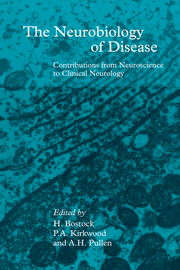Book contents
- Frontmatter
- Contents
- List of contributors
- Preface
- Part I Physiology and pathophysiology of nerve fibres
- Part II Pain
- Part III Control of central nervous system output
- 18 Synaptic transduction in neocortical neurones
- 19 Cortical circuits, synchronization and seizures
- 20 Physiologically induced changes of brain temperature and their effect on extracellular field potentials
- 21 Fusimotor control of the respiratory muscles
- 22 Cerebral accompaniments and functional significance of the long-latency stretch reflexes in human forearm muscles
- 23 The cerebellum and proprioceptive control of movement
- 24 Roles of the lateral nodulus and uvula of the cerebellum in cardiovascular control
- 25 Central actions of curare and gallamine: implications for reticular reflex myoclonus?
- 26 Pathophysiology of upper motoneurone disorders
- 27 Modulation of hypoglossal motoneurones by thyrotropin-releasing hormone and serotonin
- 28 Serotonin and central respiratory disorders in the newborn
- 29 Are medullary respiratory neurones multipurpose neurones?
- 30 Reflex control of expiratory motor output in dogs
- 31 Abnormal thoraco-abdominal movements in patients with chronic lung disease
- 32 Respiratory rhythms and apnoeas in the newborn
- 33 Cardiorespiratory interactions during apnoea
- 34 Impairment of respiratory control in neurological disease
- 35 The respiratory muscles in neurological disease
- Part IV Development, survival, regeneration and death
- Index
21 - Fusimotor control of the respiratory muscles
from Part III - Control of central nervous system output
Published online by Cambridge University Press: 04 August 2010
- Frontmatter
- Contents
- List of contributors
- Preface
- Part I Physiology and pathophysiology of nerve fibres
- Part II Pain
- Part III Control of central nervous system output
- 18 Synaptic transduction in neocortical neurones
- 19 Cortical circuits, synchronization and seizures
- 20 Physiologically induced changes of brain temperature and their effect on extracellular field potentials
- 21 Fusimotor control of the respiratory muscles
- 22 Cerebral accompaniments and functional significance of the long-latency stretch reflexes in human forearm muscles
- 23 The cerebellum and proprioceptive control of movement
- 24 Roles of the lateral nodulus and uvula of the cerebellum in cardiovascular control
- 25 Central actions of curare and gallamine: implications for reticular reflex myoclonus?
- 26 Pathophysiology of upper motoneurone disorders
- 27 Modulation of hypoglossal motoneurones by thyrotropin-releasing hormone and serotonin
- 28 Serotonin and central respiratory disorders in the newborn
- 29 Are medullary respiratory neurones multipurpose neurones?
- 30 Reflex control of expiratory motor output in dogs
- 31 Abnormal thoraco-abdominal movements in patients with chronic lung disease
- 32 Respiratory rhythms and apnoeas in the newborn
- 33 Cardiorespiratory interactions during apnoea
- 34 Impairment of respiratory control in neurological disease
- 35 The respiratory muscles in neurological disease
- Part IV Development, survival, regeneration and death
- Index
Summary
The first observations
Following the demonstration by Leksell (1945) of the fusimotor effects of γ-efferent fibres and their detailed study by Kuffler, Hunt & Quilliam (1951), their chief action was thought to be to bias spindle afferent firing. Hunt & Kuffler (1951) emphasized the usefulness of this in preventing silencing of spindles during active muscle shortening, while Merton (1953) visualized it as a way of operating a ‘length follow-up servo’ system. By the end of the 1950s much ground work had been done on the fusimotor system, principally in hindlimb muscles, and Granit's view had become established that the γ loop was generally co-activated with direct drive to α-motoneurones (Granit, 1955; Granit, Kellerth & Szumski, 1966).
In the early 1960s, the respiratory system was recognized as a convenient model for the organization of motor control. Tom Sears was involved in a series of studies laying the foundations for this approach. Intracellular recording demonstrated the monosynaptic connections of muscle afferents to intercostal motoneurones (Eccles, Sears & Shealy, 1962) and the inhibitory as well as excitatory effects of descending respiratory drive (Sears, 1964c). He also provided important background information on the afferent and efferent fibre diameter spectra (Sears, 1964a) and on motor unit types in intercostal muscles (Andersen & Sears, 1964) and introduced recording from natural intramuscular nerve filaments of intercostal muscles, in which the action potentials of a and α motor fibres could be distinguished by their different amplitudes (Sears, 1962, 1963).
- Type
- Chapter
- Information
- The Neurobiology of DiseaseContributions from Neuroscience to Clinical Neurology, pp. 231 - 240Publisher: Cambridge University PressPrint publication year: 1996
- 1
- Cited by

